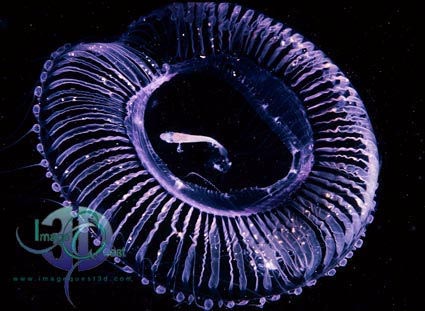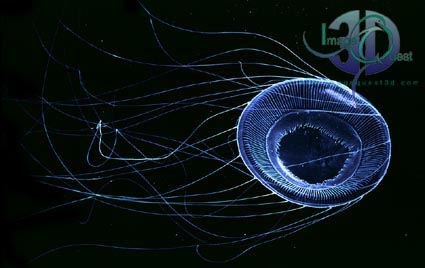News
|
Glowing
prospects for gene therapy or just a lot of monkey business?
American
scientists from the Oregon
Health Sciences University (OHSU) have perfected a new technique,
that can create genetically modified nonhuman primate (NHP) models
that will ultimately lead to a better understanding of genetic diseases
in humans such as breast cancer, HIV and Alzheimers. The study is
reported in this month's journal Molecular Human Reproduction.
|
|
Hydromedusan
- Aequoria
|
Researchers
have successfully placed jellyfish genes into rhesus monkey macaque
embryos. The jellyfish gene, derived from a type of bioluminescent
hydromedusan (Aequoria) see pictures, was chosen because
it instructs cells to produce a green flourescent protein (GFP)
that acts as a kind of biological marker. When studied under ultra
violet lighting the gene displays a green glow, making it relatively
easy to track whether it has been transfered into a target embryo.
The experiment was also designed to study the safety of a technique
that is widely used in fertility clinics to help infertile men
father biological children. The innovative proceedure (Intracytoplasmic
Sperm Injection - ICSI) inolves using a fine needle to inject
the man's sperm cells one at a time into the mother's egg cells.
In
this experiment the OHSU researchers, under the direction of Gerald
Schatten (lab coordinator and developmental biologist), first
mixed the sperm of a rhesus monkey in a dish with strands of DNA
containing the jellyfish gene. The DNA stuck to the outside of
the rhesus sperm and was then transfered, via injection, into
the egg cells. This successful transfer poses a potential area
of risk in infertility treatments, because normally the membrane
surrounding an egg excludes such alien DNA from viruses and other
contaminants. "ICSI gets around a barrier to infections that
we hadn't previously known existed," said Schatten, also
adding that fertility clinics may need to develop ways to decontaminate
sperm before attempting to inject them into eggs.
|
Within
two days, more than one third of the monkey embryos produced by
using the technique had begun to produce the flourescent green
protein. In total, twenty genetically modified embryos were then
transfered into the wombs of recipient rhesus monkey females.
This experiment resulted in five pregnancies and three healthy
male offspring. One of which is called ANDi (inserted DNA spelled
backwards)
The
presence of the foreign gene in ANDi has been verified by DNA
analysis and his birth proves that transgenICSI is a viable method
to ultimately produce genetically modified models for human disease.
Such transgenic monkeys could be used to investigate the molecular
basis of diseases such as cystic fibrosis, Alzheimer's, diabetes
and muscular dystrophy which are currently being investigated
using transgenic mice.
|

Bioluminescent bell
of Aequoria
|
|
This
experiment fuels the debate of genetic engineering in humans. However,
researchers at OHSU's primate centre said that they doubted that
the same technique they used could be used to put new genes - for
instance ones believed to correct or prevent diseases - into human
embryos. Gerald Schatten claimed that "we do not support extending
any of this in humans", also empasising the fact that "our
goal is in making fertility treatments safer and creating better
disease models for studying devastating human disorders."

Hydromedusan
with streaming tentacles - Aequoria
|
|
This
research was conducted by Anthony
Chan, Ph.D., a staff scientist at Oregon Regional Primate
Research Center and colleagues. Scientists were directed by Gerald
Schatten, Ph.D., a senior scientist at the ORPRC; research director
of the Center for Women's Health; and professor of obstetrics and
gynecology, and cell and developmental biology, in OHSU's School
of Medicine. These results were published in the Jan. 12 2001 issue
of Science.
|
 Learn
more about the applications of GFP Learn
more about the applications of GFP |
 Molecular Human Reproduction Online
Molecular Human Reproduction Online |
Click below to view more news articles

|